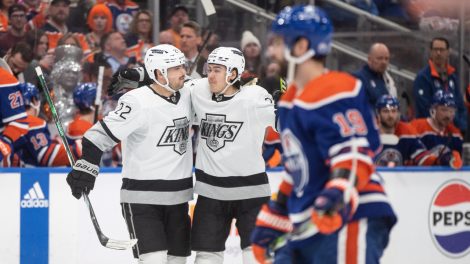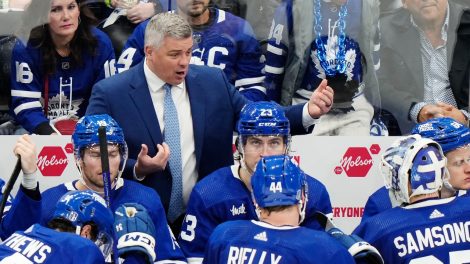When the Markham Thunder defeated the Kunlun Red Star to win the 2018 Clarkson Cup, the Canadian Women’s Hockey League was one of two women’s pro hockey leagues to celebrate a champion on Sunday.
Some day it could be just one.
Today, the National Women’s Hockey League and CWHL each etched new names into their respective trophies, with the CWHL’s Thunder winning their first Clarkson Cup on the strength of a Laura Stacey overtime goal.
The prospect of a singular women’s professional league hosting the best talent in the world is tantalizing and contentious, but one that may have just needed a little push.
Or rather, a pair of big ones.
Whenever NHL commissioner Gary Bettman speaks publicly, it’s with intent. He has rarely spoken about women’s hockey, so when he did last month at a press conference, it caught the community’s attention.
The topic was two-fold: uniting the two North American women’s leagues, and doing so under the umbrella of the NHL. Imagine the NBA’s relationship with the WNBA and you have an impression of the scale of this venture.
“We are going to let the landscape sort itself out,” Bettman said on Feb. 28. “If those two leagues didn’t exist, we would probably start our own women’s league to work in conjunction with our existing clubs.
“If at some point they both want to work with us in ways we haven’t been able to so far, we are open to that conversation.”
No one yet knows how this could work. But the desire is there from many parties. Though whether or not women’s pro hockey should unite, unite under the NHL’s guidance, or not unite at all is a valid question making this discussion murky.
For Cassie Campbell-Pascall though, it’s crystal clear.
The decorated former player and NHL colour commentator went nuclear with comments made recently on Sporstnet radio and a Sportsnet CWHL television broadcast. Spurred by Bettman’s comments, and calling for one women’s league under the NHL, Campbell-Pascall particularly called on the commissioners of both women’s leagues to step out of the way of progress.
The former director and governor of the CWHL’s member board resigned just five days before Sunday’s Clarkson Cup. Though her position the last two years was largely symbolic on her part, her decision to leave sent as strong a message to the sport’s community as her on-air comments.
“You have to point the finger at both commissioners,” she said on the radio earlier this month. “To me, they’re both not doing their jobs. Enough is enough. Let’s take women’s hockey to the next level.”
She wasn’t done there.
“We have two leagues standing in the way of the process of what’s best for women’s hockey. I’m gonna be like a hawk on this [topic], I don’t care anymore. I’m tired of individual commissioners who want to be the hero of the game.”
Neither CWHL commissioner Brenda Andress nor NWHL commissioner Dani Rylan were made available for interviews for this article, but both provided a statement.
From Andress: “The CWHL has always believed in one league. This is something we have pursued and will continue to pursue as we believe a singular league, boosted by the infrastructure of strong partners and sponsors, is where the future of the women’s professional game has always been heading.”
Though when asked about it last year, Andress said to The Athletic: “If you asked Pepsi would they join with Coke, what would they say?”
So one league is acceptable as long as it doesn’t involve the NWHL.
[relatedlinks]
From the NWHL’s Rylan: “We are always available for conversations with players, leagues, governing bodies, associations, sponsors and business leaders who want to collaborate on positive steps for the game.”
One league is seemingly the goal, but what if a merger can’t be settled upon?
The two leagues collaborated on an outdoor game at the 2016 NHL Winter Classic but the event almost did not take place after a strained negotiation. Rylan formed the four-team NWHL three years ago after a failed attempt to bring a CWHL franchise to New York. The NWHL began with the promise to pay players salaries, which have since been cut in half, but it was enough to garner interest from a large American market of players and fans. Much of the CWHL’s Boston franchise, led by Olympians like Hilary Knight, left for the new Boston Pride of the NWHL in 2015.
Knight, meanwhile, signed this month with Les Canadiennes de Montreal who lost out to Markham in the semis. It’s not yet clear whether she will return to the Canadiennes next season.
The CWHL began paying its players $2,000-$10,000 salaries this year in its 11th season, a result of slow, measured growth as well as through the investment of the Kunlun Red Star ownership group led by Billy Ngok.
But measured growth, though beneficial in some ways for the CWHL, is not enough for Campbell-Pascall who’s got many of the players themselves singing her tune. Those from both sides of the border have taken up the hashtag “OneLeague” since Campbell-Pascall’s remarks. Olympians like American Monique Lamoureux-Morando and Canadian Marie-Philip Poulin would certainly like to play against the best in the world, but even the non-Olympians mostly agree. The CWHL Players’ Association tweeted after Bettman’s comments, saying “Now is the time to work with the NHL to secure #OneLeague where the best in the world can compete.”
“Bettman’s statement opened the doors for us players to say that’s something we’re interested in,” CWHLPA co-chair and Thunder goalie Liz Knox said to me earlier this month. “It was our way of addressing not only the NHL but also the CW and players outside the CWHL. We wanted to say, ‘Let’s not pass on this opportunity.’”
Currently, there are a handful of partnerships between NHL clubs and local women’s teams, such as one between the Toronto Maple Leafs and the CW’s Toronto Furies. The NHLPA has also begun to work with the CWHLPA.
“We don’t need the NHL to take care of us, I think we should take care of ourselves,” said Red Star head coach Digit Murphy. “We have the obligation to lead ourselves. And I’m not saying that men shouldn’t be involved [in running a league] or that it should be women-only. It would be great if the NHL could come in and help [with advice].”
But others see Bettman’s press conference remarks as a departure from the NHL’s previous track record.
“Of course any relationship that you’re trying to form has the potential for road blocks,” Knox said. “But I think that Bettman has addressed [women’s hockey] shows a lot of growth in his mentality, whereas four years ago it was, ‘We’re not touching [it].’ As players, we choose to see it as a step in the right direction for the NHL.”
There are legal and logistical barriers to one women’s league forming. The seven-team CWHL is centrally funded, meaning teams are not owned by individuals or groups, and now have two teams based in China that are ownership-run. The NWHL is more like the NHL in that regard. Each league has a team in Boston, and contraction of teams and the loss of roster spots seems likely and potentially damaging to the sport in the short term.
Campbell-Pascall told The Canadian Press this week that she thought a solution could be found in “two weeks of meetings” between both leagues.
Neither league is talking much about it, nor are they obliged to. But a murmur from the community is growing to a chorus, and some powerful figures in the sport are leading the choir.
The question is who will conduct.








